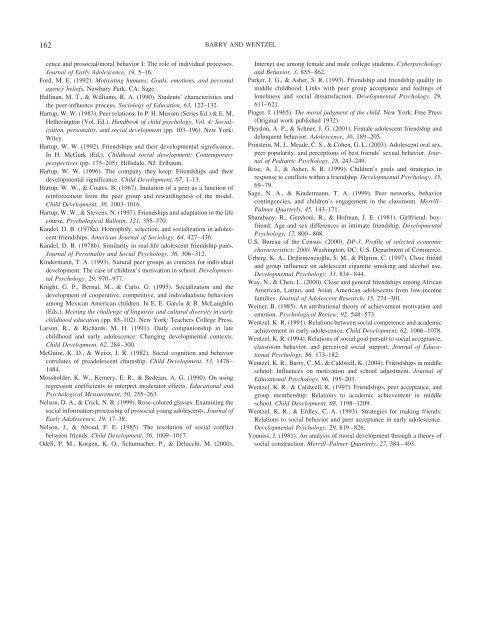Friend Influence on Prosocial Behavior: The Role of Motivational ...
Friend Influence on Prosocial Behavior: The Role of Motivational ...
Friend Influence on Prosocial Behavior: The Role of Motivational ...
You also want an ePaper? Increase the reach of your titles
YUMPU automatically turns print PDFs into web optimized ePapers that Google loves.
162<br />
cence and prosocial/moral behavior I: <strong>The</strong> role <strong>of</strong> individual processes.<br />
Journal <strong>of</strong> Early Adolescence, 19, 5–16.<br />
Ford, M. E. (1992). Motivating humans: Goals, emoti<strong>on</strong>s, and pers<strong>on</strong>al<br />
agency beliefs. Newbury Park, CA: Sage.<br />
Hallinan, M. T., & Williams, R. A. (1990). Students’ characteristics and<br />
the peer-influence process. Sociology <strong>of</strong> Educati<strong>on</strong>, 63, 122–132.<br />
Hartup, W. W. (1983). Peer relati<strong>on</strong>s. In P. H. Mussen (Series Ed.) & E. M.<br />
Hetheringt<strong>on</strong> (Vol. Ed.), Handbook <strong>of</strong> child psychology, Vol. 4: Socializati<strong>on</strong>,<br />
pers<strong>on</strong>ality, and social development (pp. 103–196). New York:<br />
Wiley.<br />
Hartup, W. W. (1992). <str<strong>on</strong>g>Friend</str<strong>on</strong>g>ships and their developmental significance.<br />
In H. McGurk (Ed.), Childhood social development: C<strong>on</strong>temporary<br />
perspectives (pp. 175–205). Hillsdale, NJ: Erlbaum.<br />
Hartup, W. W. (1996). <strong>The</strong> company they keep: <str<strong>on</strong>g>Friend</str<strong>on</strong>g>ships and their<br />
developmental significance. Child Development, 67, 1–13.<br />
Hartup, W. W., & Coates, B. (1967). Imitati<strong>on</strong> <strong>of</strong> a peer as a functi<strong>on</strong> <strong>of</strong><br />
reinforcement from the peer group and rewardingness <strong>of</strong> the model.<br />
Child Development, 38, 1003–1016.<br />
Hartup, W. W., & Stevens, N. (1997). <str<strong>on</strong>g>Friend</str<strong>on</strong>g>ships and adaptati<strong>on</strong> in the life<br />
course. Psychological Bulletin, 121, 355–370.<br />
Kandel, D. B. (1978a). Homophily, selecti<strong>on</strong>, and socializati<strong>on</strong> in adolescent<br />
friendships. American Journal <strong>of</strong> Sociology, 64, 427–436.<br />
Kandel, D. B. (1978b). Similarity in real-life adolescent friendship pairs.<br />
Journal <strong>of</strong> Pers<strong>on</strong>ality and Social Psychology, 36, 306–312.<br />
Kindermann, T. A. (1993). Natural peer groups as c<strong>on</strong>texts for individual<br />
development: <strong>The</strong> case <strong>of</strong> children’s motivati<strong>on</strong> in school. Developmental<br />
Psychology, 29, 970–977.<br />
Knight, G. P., Bernal, M., & Carlo, G. (1995). Socializati<strong>on</strong> and the<br />
development <strong>of</strong> cooperative, competitive, and individualistic behaviors<br />
am<strong>on</strong>g Mexican American children. In E. E. Garcia & B. McLaughlin<br />
(Eds.), Meeting the challenge <strong>of</strong> linguistic and cultural diversity in early<br />
childhood educati<strong>on</strong> (pp. 85–102). New York: Teachers College Press.<br />
Lars<strong>on</strong>, R., & Richards, M. H. (1991). Daily compani<strong>on</strong>ship in late<br />
childhood and early adolescence: Changing developmental c<strong>on</strong>texts.<br />
Child Development, 62, 284–300.<br />
McGuire, K. D., & Weisz, J. R. (1982). Social cogniti<strong>on</strong> and behavior<br />
correlates <strong>of</strong> preadolescent chumship. Child Development, 53, 1478–<br />
1484.<br />
Mossholder, K. W., Kemery, E. R., & Bedeian, A. G. (1990). On using<br />
regressi<strong>on</strong> coefficients to interpret moderator effects. Educati<strong>on</strong>al and<br />
Psychological Measurement, 50, 255–263.<br />
Nels<strong>on</strong>, D. A., & Crick, N. R. (1999). Rose-colored glasses: Examining the<br />
social informati<strong>on</strong>-processing <strong>of</strong> prosocial young adolescents. Journal <strong>of</strong><br />
Early Adolescence, 19, 17–38.<br />
Nels<strong>on</strong>, J., & Aboud, F. E. (1985). <strong>The</strong> resoluti<strong>on</strong> <strong>of</strong> social c<strong>on</strong>flict<br />
between friends. Child Development, 56, 1009–1017.<br />
Odell, P. M., Korgen, K. O., Schumacher, P., & Delucchi, M. (2000).<br />
BARRY AND WENTZEL<br />
Internet use am<strong>on</strong>g female and male college students. Cyberpsychology<br />
and <strong>Behavior</strong>, 3, 855–862.<br />
Parker, J. G., & Asher, S. R. (1993). <str<strong>on</strong>g>Friend</str<strong>on</strong>g>ship and friendship quality in<br />
middle childhood: Links with peer group acceptance and feelings <strong>of</strong><br />
l<strong>on</strong>eliness and social dissatisfacti<strong>on</strong>. Developmental Psychology, 29,<br />
611–621.<br />
Piaget, J. (1965). <strong>The</strong> moral judgment <strong>of</strong> the child. New York: Free Press<br />
(Original work published 1932)<br />
Pleyd<strong>on</strong>, A. P., & Schner, J. G. (2001). Female adolescent friendship and<br />
delinquent behavior. Adolescence, 36, 189–205.<br />
Prinstein, M. J., Meade, C. S., & Cohen, G. L. (2003). Adolescent oral sex,<br />
peer popularity, and percepti<strong>on</strong>s <strong>of</strong> best friends’ sexual behavior. Journal<br />
<strong>of</strong> Pediatric Psychology, 28, 243–249.<br />
Rose, A. J., & Asher, S. R. (1999). Children’s goals and strategies in<br />
resp<strong>on</strong>se to c<strong>on</strong>flicts within a friendship. Developmental Psychology, 35,<br />
69–79.<br />
Sage, N. A., & Kindermann, T. A. (1999). Peer networks, behavior<br />
c<strong>on</strong>tingencies, and children’s engagement in the classroom. Merrill–<br />
Palmer Quarterly, 45, 143–171.<br />
Sharabany, R., Gersh<strong>on</strong>i, R., & H<strong>of</strong>man, J. E. (1981). Girlfriend, boyfriend:<br />
Age and sex differences in intimate friendship. Developmental<br />
Psychology, 17, 800–808.<br />
U.S. Bureau <strong>of</strong> the Census. (2000). DP-3. Pr<strong>of</strong>ile <strong>of</strong> selected ec<strong>on</strong>omic<br />
characteristics: 2000. Washingt<strong>on</strong>, DC: U.S. Department <strong>of</strong> Commerce.<br />
Urberg, K. A., Degˇirmenciogˇlu, S. M., & Pilgrim, C. (1997). Close friend<br />
and group influence <strong>on</strong> adolescent cigarette smoking and alcohol use.<br />
Developmental Psychology, 33, 834–844.<br />
Way, N., & Chen, L. (2000). Close and general friendships am<strong>on</strong>g African<br />
American, Latino, and Asian American adolescents from low-income<br />
families. Journal <strong>of</strong> Adolescent Research, 15, 274–301.<br />
Weiner, B. (1985). An attributi<strong>on</strong>al theory <strong>of</strong> achievement motivati<strong>on</strong> and<br />
emoti<strong>on</strong>. Psychological Review, 92, 548–573.<br />
Wentzel, K. R. (1991). Relati<strong>on</strong>s between social competence and academic<br />
achievement in early adolescence. Child Development, 62, 1066–1078.<br />
Wentzel, K. R. (1994). Relati<strong>on</strong>s <strong>of</strong> social goal pursuit to social acceptance,<br />
classroom behavior, and perceived social support. Journal <strong>of</strong> Educati<strong>on</strong>al<br />
Psychology, 86, 173–182.<br />
Wentzel, K. R., Barry, C. M., & Caldwell, K. (2004). <str<strong>on</strong>g>Friend</str<strong>on</strong>g>ships in middle<br />
school: <str<strong>on</strong>g>Influence</str<strong>on</strong>g>s <strong>on</strong> motivati<strong>on</strong> and school adjustment. Journal <strong>of</strong><br />
Educati<strong>on</strong>al Psychology, 96, 195–203.<br />
Wentzel, K. R., & Caldwell, K. (1997). <str<strong>on</strong>g>Friend</str<strong>on</strong>g>ships, peer acceptance, and<br />
group membership: Relati<strong>on</strong>s to academic achievement in middle<br />
school. Child Development, 68, 1198–1209.<br />
Wentzel, K. R., & Erdley, C. A. (1993). Strategies for making friends:<br />
Relati<strong>on</strong>s to social behavior and peer acceptance in early adolescence.<br />
Developmental Psychology, 29, 819–826.<br />
Youniss, J. (1981). An analysis <strong>of</strong> moral development through a theory <strong>of</strong><br />
social c<strong>on</strong>structi<strong>on</strong>. Merrill–Palmer Quarterly, 27, 384–403.
















